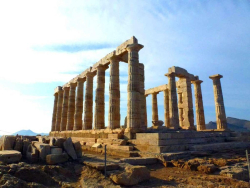Poseidon Temple (Sounio)

Poseidon Temple (Sounio)
It is divided into three parts, the vestibule, the nave, with the statue of the god of the sea, and the "back facade", where the offerings were kept, as well as "Poseidon’s money" deriving from the mines of Lavrion. The vestibule and "the back facade" lead to two columns between pilasters.
The vestibule and the "back façade" are separated from the nave by a wall. A special feature of the Poseidon’s temple is the lack of internal colonnade in the cell. The height of the columns is 6.12 meters. A special feature that makes this temple so unique is the fact that the streaks are only 16 instead of twenty, which was usual in the construction of temples at the time.
The tops of the columns support the architrave, the metopes, and the triglyphs. None of the panels were decorated, due to the fact that Poseidon was characterized as a stern and austere God.
The interior space formed between the entrance of the "pronaos" and the outer colonnade was made of anaglyphs and occupied all four walls. The sculptures were made of Parian marble and were dedicated to the Giants, the Centauromachy and the Labors of Theseus. Unfortunately, due to inclement weather conditions, most of the anaglyphs have been eroded. Whatever survived, is now kept at the Archaeological Museum of Lavrio.
While walking around the archaeological site, seize the opportunity and learn from local tour guides about Greek Mythology and heroic acts that have been linked to the history of the region and this sacred place. If you choose to hire and follow one of the local guides for greater insight, you will also enjoy the beautiful side of this city that is well hidden in earthly paradises outside the center awaiting to be discovered!












